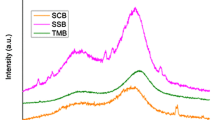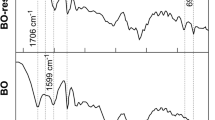Abstract
Short sugarcane bagasse fibers, an agro-residue vastly produced worldwide, with Brazil being the leading producer, were used to reinforce brittle phenolic-type thermosets formed from resins synthesized using lignosulfonate to replace phenol. Glutaraldehyde, which has a lower vapor pressure than formaldehyde, was tested in the lignophenolic resin synthesis to improve the composite processability. Both composites, Glu-SLig (C) and For-SLig (C), formed from glutaraldehyde/sodium lignosulfonate and formaldehyde/sodium lignosulfonate resins, respectively, showed a higher impact and flexural strength than their respective non-reinforced thermosets. This may be attributed to the compatibility between the lignophenolic matrix and sugarcane bagasse fibers, indicated by their nearby free surface energy density dispersive component values. Glu-SLig(C) presented impact resistance (≅20%), flexural modulus (≅45%), and Tg values higher than For-SLig(C). Lignophenolic thermoset composites formed from a high volume of plant-based materials can be an excellent alternative to materials used in non-structural applications, such as rigid packaging and automotive interior parts.











Similar content being viewed by others
Data availability
The manuscript provided the data set generated during the reported study.
References
Chen S, Wang G, Pang T, Sui W, Chen Z, Si C (2021) Green assembly of high-density and small-sized silver nanoparticles on lignosulfonate-phenolic resin spheres: Focusing on multifunction of lignosulfonate. Int J Biol Macromol 166:893–901. https://doi.org/10.1016/j.ijbiomac.2020.10.246
Yamini G, Shakeri A, Zohuriaan-Mehr MJ, Kabiri K (2018) Cyclocarbonated lignosulfonate as a bio-resourced reactive reinforcing agent for epoxy biocomposite: From natural waste to value-added bio-additive. J CO2 Util 24:50–58. https://doi.org/10.1016/j.jcou.2017.12.007
de Matos PR, Sakata RD, Foiato M, Repette WL, Gleize PJP (2021) Workability maintenance of water-reducing admixtures in high-performance pastes produced with different types of Portland cement. Rev Mater 26. https://doi.org/10.1590/s1517-707620210001.1225
Ouyang X, Qiu X, Chen P (2006) Physicochemical characterization of calcium lignosulfonate—A potentially useful water reducer. Colloids Surfaces A Physicochem Eng Asp 282–283:489–497. https://doi.org/10.1016/J.COLSURFA.2005.12.020
Qin Y, Yang D, Qiu X (2015) Hydroxypropyl Sulfonated Lignin as Dye Dispersant: Effect of Average Molecular Weight. ACS Sustain Chem Eng 3:3239–3244. https://doi.org/10.1021/acssuschemeng.5b00821
Yu L, Yu J, Mo W, Qin Y, Yang D, Qiu X (2016) Etherification to improve the performance of lignosulfonate as dye dispersant. RSC Adv 6:70863–70869. https://doi.org/10.1039/c6ra12173j
Peng R, Pang Y, Qiu X, Qian Y, Zhou M (2020) Synthesis of anti-photolysis lignin-based dispersant and its application in pesticide suspension concentrate. RSC Adv 10:13830–13837. https://doi.org/10.1039/c9ra10626j
Liu Y, Nie W, Mu Y, Zhang H, Wang H, ** H, Liu Z (2018) A synthesis and performance evaluation of a highly efficient ecological dust depressor based on the sodium lignosulfonate-acrylic acid graft copolymer. RSC Adv 8:11498–11508. https://doi.org/10.1039/c7ra12556a
Antov P, Savov V, Mantanis GI, Neykov N (2021) Medium-density fibreboards bonded with phenol-formaldehyde resin and calcium lignosulfonate as an eco-friendly additive, Wood. Mater Sci Eng 16:42–48. https://doi.org/10.1080/17480272.2020.1751279
de Oliveira F, Gonçalves LP, Belgacem MN, Frollini E (2020) Polyurethanes from plant- and fossil-sourced polyols: Properties of neat polymers and their sisal composites. Ind Crop Prod 155:112821. https://doi.org/10.1016/J.INDCROP.2020.112821
Ghorbani M, Konnerth J, van Herwijnen HWG, Zinovyev G, Budjav E, Requejo Silva A, Liebner F (2018) Commercial lignosulfonates from different sulfite processes as partial phenol replacement in PF resole resins. J Appl Polym Sci 135:1–11. https://doi.org/10.1002/app.45893
Hu L, Zhou Y, Zhang M, Liu R (2012) Characterization and properties of a lignosulfonate-based phenolic foam. BioResources. 7:554–564. https://doi.org/10.15376/biores.7.1.554-564
Megiatto JD, Cerrutti BM, Frollini E (2016) Sodium lignosulfonate as a renewable stabilizing agent for aqueous alumina suspensions. Int J Biol Macromol 82:927–932. https://doi.org/10.1016/J.IJBIOMAC.2015.11.004
de Oliveira F, Ramires EC, Frollini E, Belgacem MN (2015) Lignopolyurethanic materials based on oxypropylated sodium lignosulfonate and castor oil blends. Ind Crop Prod 72:77–86. https://doi.org/10.1016/J.INDCROP.2015.01.023
de Oliveira F, da Silva CG, Ramos LA, Frollini E (2017) Phenolic and lignosulfonate-based matrices reinforced with untreated and lignosulfonate-treated sisal fibers. Ind Crop Prod 96:30–41. https://doi.org/10.1016/J.INDCROP.2016.11.027
Ruwoldt J (2020) A Critical Review of the Physicochemical Properties of Lignosulfonates: Chemical Structure and Behavior in Aqueous Solution, at Surfaces and Interfaces. Surfaces 2020(3):622–648. https://doi.org/10.3390/surfaces3040042
Aro T, Fatehi P (2017) Production and Application of Lignosulfonates and Sulfonated Lignin. ChemSusChem 10:1861–1877. https://doi.org/10.1002/cssc.201700082
Kaschuk JJ, Ferracini TV, Nitschke M, Frollini E (2023) Lignosulfonate as biosurfactant for the enzymatic conversion of sisal lignocellulosic fiber into fermentable sugars. Biomass Conv Bioref. https://doi.org/10.1007/s13399-023-04318-2
Gonçalves S, Ferra J, Paiva N, Martins J, Carvalho LH, Magalhães FD (2021) Lignosulphonates as an Alternative to Non-Renewable Binders in Wood-Based Materials. Polymers (Basel) 30:4196. https://doi.org/10.3390/polym13234196
Ganewatta MS, Lokupitiya HN, Tang C (2019) Lignin biopolymers in the age of controlled polymerization. Polymers (Basel) 11. https://doi.org/10.3390/polym11071176
Gallo JMR, Trapp MA (2017) The chemical conversion of biomass-derived saccharides: An overview. J Braz Chem Soc 28:1586–1607. https://doi.org/10.21577/0103-5053.20170009
Serrano-Ruiz JC (2020) Biomass: A Renewable Source of Fuels, Chemicals and Carbon Materials. Molecules 25:5217. https://doi.org/10.3390/molecules25215217
Ohra-Aho T, Rohrbach L, Winkelman JGM, Heeres HJ, Mikkelson A, Oasmaa A, Van De Beld B, Leijenhorst EJ, Heeres H (2021) Evaluation of Analysis Methods for Formaldehyde, Acetaldehyde, and Furfural from Fast Pyrolysis Bio-oil. Energy Fuel 35:18583–18591. https://doi.org/10.1021/acs.energyfuels.1c02208
Sarika PR, Nancarrow P, Khansaheb A, Ibrahim T (2020) Bio-Based Alternatives to Phenol and Formaldehyde for the Production of Resins. Polym 12:1–24
B.W. Darvell, More Chemistry, Mater. Sci. Dent (2018) 771–789. https://doi.org/10.1016/B978-0-08-101035-8.50030-4.
Lee CH, Khalina A, Lee SH (2021) Importance of interfacial adhesion condition on characterization of plant-fiber-reinforced polymer composites: A review. Polymers (Basel) 13:1–22. https://doi.org/10.3390/polym13030438
Pereira PHF, De Freitas Rosa M, Cioffi MOH, De Carvalho Benini KCC, Milanese AC, Voorwald HJC, Mulinari DR (2015) Vegetal fibers in polymeric composites: A review. Polimeros 25:9–22. https://doi.org/10.1590/0104-1428.1722
Rojo E, Alonso MV, Oliet M, Del Saz-Orozco B, Rodriguez F (2015) Effect of fiber loading on the properties of treated cellulose fiber-reinforced phenolic composites. Compos Part B Eng 68:185–192. https://doi.org/10.1016/J.COMPOSITESB.2014.08.047
FAO (2021) World Food and Agriculture – Statistical Yearbook 2021. https://doi.org/10.4060/cb4477en
Khodafarin R, Tavasoli A, Rashidi A (2020) Single-step conversion of sugarcane bagasse to biofuel over Mo-supported graphene oxide nanocatalyst. Biomass Convers Biorefinery:20–23. https://doi.org/10.1007/s13399-020-01037-w
Awais M, Li W, Munir A, Omar MM, Ajmal M (2021) Experimental investigation of downdraft biomass gasifier fed by sugarcane bagasse and coconut shells. Biomass Convers Biorefinery 11:429–444. https://doi.org/10.1007/s13399-020-00690-5
da Silva DDV, Machado E, Danelussi O, dos Santos MG, da Silva SS, Dussán KJ (2022) Repeated-batch fermentation of sugarcane bagasse hemicellulosic hydrolysate to ethanol using two xylose-fermenting yeasts. Biomass Convers Biorefinery. https://doi.org/10.1007/s13399-021-02199-x
Huong LM, Trung TQ, Tuan TT, Viet NQ, Dat NM, Nghiem DG, Thinh DB, Tinh NT, Oanh DTY, Phuong NT, Nam HM, Phong MT, Hieu NH (2022) Surface functionalization of graphene oxide by sulfonation method to catalyze the synthesis of furfural from sugarcane bagasse. Biomass Convers Biorefinery. https://doi.org/10.1007/s13399-021-02272-5
de Souza Queiroz S, Jofre FM, dos Santos HA, Hernández-Pérez AF, Felipe MDGDA (2021) Xylitol and ethanol co-production from sugarcane bagasse and straw hemicellulosic hydrolysate supplemented with molasses, Biomass Convers. Biorefinery. https://doi.org/10.1007/s13399-021-01493-y
Hernández-Pérez AF, Antunes FAF, dos Santos JC, da Silva SS, Felipe MDGDA (2020) Valorization of the sugarcane bagasse and straw hemicellulosic hydrolysate through xylitol bioproduction: effect of oxygen availability and sucrose supplementation as key factors, Biomass Convers. Biorefinery. https://doi.org/10.1007/s13399-020-00993-7
da Silva CG, de Oliveira F, Frollini E (2019) Sugarcane Bagasse Fibers Treated and Untreated: Performance as Reinforcement in Phenolic-Type Matrices Based on Lignosulfonates. Waste and Biomass Valorization 10:3515–3524. https://doi.org/10.1007/s12649-018-0365-z
da Silva CG, Frollini E (2020) Unburned Sugarcane Bagasse: Bio-based Phenolic Thermoset Composites as an Alternative for the Management of this Agrowaste. J Polym Environ 28:3201–3210. https://doi.org/10.1007/s10924-020-01848-y
Md Salim R, Asik J, Sarjadi MS (2021) Chemical functional groups of extractives, cellulose and lignin extracted from native Leucaena leucocephala bark. Wood Sci Technol 55:295–313. https://doi.org/10.1007/s00226-020-01258-2
Klein SE, Rumpf J, Kusch P, Albach R, Rehahn M, Witzleben S, Schulze M (2018) Unmodified kraft lignin isolated at room temperature from aqueous solution for preparation of highly flexible transparent polyurethane coatings. RSC Adv 8:40765–40777. https://doi.org/10.1039/C8RA08579J
Zhou H, Yang D, Zhu JY (2016) Molecular Structure of Sodium Lignosulfonate from Different Sources and their Properties as Dispersant of TiO2 Slurry. J Dispers Sci Technol 37:296–303. https://doi.org/10.1080/01932691.2014.989572
Palamarchuk IA, Brovko OS, Bogolitsyn KG, Boitsova TA, Ladesov AV, Ivakhnov AD (2015) Relationship of the Structure and Ion-Exchange Properties of Polyelectrolyte Complexes Based on Biopolymers. Russ J Appl Chem 88:109–114. https://doi.org/10.1134/S1070427215010152
Nurazzi NM, Asyraf MRM, Rayung M, Norrrahim MNF, Shazleen SS, Rani MSA, Shafi AR, Aisyah HA, Radzi MHM, Sabaruddin FA, Ilyas RA, Zainudin ES, Abdan K (2021) Thermogravimetric analysis properties of cellulosic natural fiber polymer composites: A review on influence of chemical treatments. Polymers (Basel) 13. https://doi.org/10.3390/polym13162710
Caydamli Y, Heudorfer K, Take J, Podjaski F, Middendorf P, Buchmeiser MR (2021) Transparent fiber-reinforced composites based on a thermoset resin using liquid composite molding (Lcm) techniques. Materials (Basel) 14. https://doi.org/10.3390/ma14206087
G.S. Divya, B. Suresha, Recent Developments of Natural Fiber Reinforced Thermoset Polymer Composites and their Mechanical Properties, Indian J. Adv. Chem Sci (2016) 267–274. http://www.ijacskros.com/artcles/IJACS-2S-56.pdf.
Sanjay MR, Arpitha GR, Senthamaraikannan P, Kathiresan M, Saibalaji MA, Yogesha B (2019) The Hybrid Effect of Jute/Kenaf/E-Glass Woven Fabric Epoxy Composites for Medium Load Applications: Impact, Inter-Laminar Strength, and Failure Surface Characterization. J Nat Fibers 16:600–612. https://doi.org/10.1080/15440478.2018.1431828
Ornaghi HL, Neves RM, Monticeli FM, Thomas S (2022) Modeling of dynamic mechanical curves of kenaf/polyester composites using surface response methodology. J Appl Polym Sci. https://doi.org/10.1002/app.52078
Hernandez TPA, Mills AR, Yazdani Nezhad H (2021) Shear driven deformation and damage mechanisms in High-performance carbon Fibre-reinforced thermoplastic and toughened thermoset composites subjected to high strain loading. Compos Struct 261:113289. https://doi.org/10.1016/j.compstruct.2020.113289
da Silva CG, Oliveira F, Ramires EC, Castellan A, Frollini E (2012) Composites from a forest biorefinery byproduct and agrofibers: Lignosulfonate-phenolic type matrices reinforced with sisal fibers. TAPPI J 11:41–49. https://doi.org/10.32964/TJ11.9.41
Cintil JC, Jithin J, Lovely M, Koetz J, Thomas S (2014) Nanofibril reinforced unsaturated polyester nanocomposites:Morphology, mechanical and barrier properties, viscoelastic behaviorand polymer chain confinement. Ind Crop Prod 56:246–254. https://doi.org/10.1016/j.indcrop.2014.03.005
Funding
CNPq (National Counsel of Technological and Scientific Development, Brazil): research productivity fellowship to E.F. (Process 309692/2017-2) and financial support (Process n° 403494/2021-4)
Author information
Authors and Affiliations
Contributions
Cristina Gomes da Silva: Conceptualization, Methodology, Formal analysis, Investigation, Data Curation, Writing - Original Draft, Writing - Review & Editing, Visualization
Bianca Groner Queiroz: Data Curation, Writing - Original Draft, Writing - Review & Editing, Visualization
Elisabete Frollini: Conceptualization, Methodology, Formal analysis, Investigation, Resources, Writing - Original Draft, Writing - Review & Editing, Visualization, Project administration, Funding acquisition
Corresponding author
Ethics declarations
Ethical approval
Not applicable.
Competing interests
The authors declare that they have no conflict of interest.
Additional information
Publisher’s Note
Springer Nature remains neutral with regard to jurisdictional claims in published maps and institutional affiliations.
Rights and permissions
Springer Nature or its licensor (e.g. a society or other partner) holds exclusive rights to this article under a publishing agreement with the author(s) or other rightsholder(s); author self-archiving of the accepted manuscript version of this article is solely governed by the terms of such publishing agreement and applicable law.
About this article
Cite this article
da Silva, C.G., Queiroz, B.G. & Frollini, E. Lignocellulosic biomass: synthesis of lignophenolic thermosets with simultaneous formation of composites reinforced by sugarcane bagasse fibers. Biomass Conv. Bioref. (2023). https://doi.org/10.1007/s13399-023-04809-2
Received:
Revised:
Accepted:
Published:
DOI: https://doi.org/10.1007/s13399-023-04809-2




